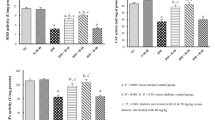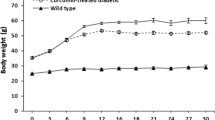Abstract
Resveratrol is a strong antioxidant that exhibits blood glucose-lowering effects, which might contribute to its usefulness in preventing complications associated with diabetes. The present study aimed to investigate resveratrol effects on catalase (CAT) and glutathione peroxidase (GPx) gene and protein expression, their phosphorylation states and activities in rat liver of STZ-induced diabetes. Diabetes increased the levels of total protein phosphorylation and p-CAT, while mRNA expression, protein levels, and activity were reduced. Although diabetes induced transcriptional repression over GPx, it did not affect the protein levels and activity. When resveratrol was administered to diabetic rats, an increase in activity was associated with an increase in p-GPx levels. Decrease in Sirtuin1 (SIRT1) and nuclear factor erythroid 2-related factor (Nrf2) and increase in nuclear factor kappa B (NFκB) gene expression in diabetes were associated with a decrease in CAT and GPx mRNA expression. A possible compensatory mechanism for reduced gene expression of antioxidant enzymes is proved to be nuclear translocation of redox-sensitive Nrf2 and NFκB in diabetes which is confirmed by the increase in nuclear and decrease in cytoplasmic protein levels of Nrf2 and NFκB. Taken together, these findings revealed that an increase in the oxidized state in diabetes intricately modified the cellular phosphorylation status and regulation of antioxidant enzymes. Gene regulation of antioxidant enzymes was accompanied by nuclear translocation of Nrf2 and NFκB. Resveratrol administration also activated a coordinated cytoprotective response against diabetes-induced changes in liver tissues.







Similar content being viewed by others
Abbreviations
- CAT:
-
Catalase
- GPx:
-
Glutathione peroxidase
- STZ:
-
Streptozotocin
- p-CAT:
-
Phosphorylated catalase
- p-GPx:
-
Phosphorylated glutathione peroxidase
- qRT-PCR:
-
Quantitative real-time PCR
- SIRT1:
-
Sirtuin1
- Nrf2:
-
Nuclear factor erythroid 2-related factor
- NFκB:
-
Nuclear factor kappa B
- ROS:
-
Reactive oxygen species
- GR:
-
Glutathione reductase
- GSH:
-
Reduced glutathione
- PAGE:
-
Sodium dodecyl sulfate (SDS)-polyacrylamide gel electrophoresis
- HRP:
-
Horseradish peroxidase
- PTPs:
-
Protein tyrosine phosphatases
- TBARS:
-
Thiobarbituric acid reactive substances
References
Giacco F, Brownlee M (2010) Oxidative stress and diabetic complications. Circ Res 107:1058–1070. doi:10.1161/CIRCRESAHA.110.223545
Pandey KB (2009) Plant polyphenols as dietary antioxidants in human health and disease. Oxid Med Cell Longev 2:270–278
Szkudelski T, Szkudelska K (2011) Anti-diabetic effects of resveratrol. Ann N Y Acad Sci 1215:34–39. doi:10.1111/j.1749-6632.2010.05844.x
Marques FZ, Markus MA, Morris BJ (2009) Resveratrol : cellular actions of a potent natural chemical that confers a diversity of health benefits. Int J Biochem Cell Biol 41:2125–2128. doi:10.1016/j.biocel.2009.06.003
Szkudelska K, Szkudelski T (2010) Resveratrol, obesity and diabetes. Eur J Pharmacol 635:1–8. doi:10.1016/j.ejphar.2010.02.054
Baur J, Sinclair D (2006) Therapeutic potential of resveratrol: the in vivo evidence. Nat Rev Drug Discov 5:493–506. doi:10.1038/nrd2060
Savouret JF, Quesne M (2002) Resveratrol and cancer: a review. Biomed Pharmacother 56:84–87
Thirunavukkarasu M, Penumathsa SV, Koneru S et al (2007) Resveratrol alleviates cardiac dysfunction in streptozotocin-induced diabetes: role of nitric oxide, thioredoxin, and heme oxygenase. Free Radic Biol Med 43:720–729. doi:10.1016/j.freeradbiomed.2007.05.004
Groen A, Lemeer S, van der Wijk T et al (2005) Differential oxidation of protein-tyrosine phosphatases. J Biol Chem 280:10298–10304. doi:10.1074/jbc.M412424200
Rhee S, Kang SW, Jeong W et al (2005) Intracellular messenger function of hydrogen peroxide and its regulation by peroxiredoxins. Curr Opin Cell Biol 17:183–189. doi:10.1016/j.ceb.2005.02.004
Rhee SG (2003) Cellular regulation by hydrogen peroxide. J Am Soc Nephrol 14:211S–215S. doi:10.1097/01.ASN.0000077404.45564.7E
Evans JL (2002) Oxidative stress and stress-activated signaling pathways: a unifying hypothesis of Type 2 diabetes. Endocr Rev 23:599–622. doi:10.1210/er.2001-0039
Lee J-M, Johnson J a (2004) An important role of Nrf2-ARE pathway in the cellular defense mechanism. J Biochem Mol Biol 37:139–143
Locke M, Anderson J (2011) NF-κB activation in organs from STZ-treated rats. Appl Physiol Nutr Metab 36:121–127. doi:10.1139/H10-094
Soufi FG, Mohammad-Nejad D, Ahmadieh H (2012) Resveratrol improves diabetic retinopathy possibly through oxidative stress—nuclear factor κB—apoptosis pathway. Pharmacol Rep 64:1505–1514
Morris BJ (2013) Seven sirtuins for seven deadly diseases of aging. Free Radic Biol Med 56:133–171. doi:10.1016/j.freeradbiomed.2012.10.525
Pillai SS, Sugathan JK, Indira M (2012) Selenium downregulates RAGE and NFκB expression in diabetic rats. Biol Trace Elem Res 149:71–77. doi:10.1007/s12011-012-9401-1
Taguchi K, Motohashi H, Yamamoto M (2011) Molecular mechanisms of the Keap1–Nrf2 pathway in stress response and cancer evolution. Genes Cells 16:123–140. doi:10.1111/j.1365-2443.2010.01473.x
Cao C, Leng Y, Kufe D (2003) Catalase activity is regulated by c-Abl and Arg in the oxidative stress response. J Biol Chem 278:29667–29675. doi:10.1074/jbc.M301292200
Cao C, Leng Y, Huang W et al (2003) Glutathione peroxidase 1 is regulated by the c-Abl and Arg tyrosine kinases. J Biol Chem 278:39609–39614. doi:10.1074/jbc.M305770200
Lowry O, Roserbrough N, Farr A, Randall R (1951) Protein measurement with folin phenol reagent. J Biol Chem 193:265–275
Towbin H, Staehelin T, Gordon J (1992) Electrophoretic transfer of proteins from polyacrylamide gels to nitrocellulose sheets: procedure and some applications. Biotechnology 24:145–149
Ellman GL (1959) Tissue sulfhydryl groups. Arch Biochem Biophys 82:70–77
Sedlak J, Lindsay RH (1968) Estimation of total, protein-bound, and nonprotein sulfhydryl groups in tissue with Ellman’s reagent. Anal Biochem 25:192–205
Jain SK, Levine SN (1995) Elevated lipid peroxidation and vitamin E-quinone levels in heart ventricles of streptozotocin-treated diabetic rats. Free Radic Biol Med 18:337–341
Levine RL, Garland D, Oliver CN et al (1990) Determination of carbonyl content in oxidatively modified proteins. Methods Enzymol 186:464–478
Aebi H (1984) In methods in enzymology. Catalase Vitr. Academy Press, New York, pp 121–126
Paglia D, Valentine W (1967) Studies on the quantitative and qualitative characterization of erythrocyte glutathione peroxidase. J Lab Clin Med 70:158–169
Baur JA (2010) Resveratrol, sirtuins, and the promise of a DR mimetic. Mech Ageing Dev 131:261–269. doi:10.1016/j.mad.2010.02.007
Zhang J (2006) Resveratrol inhibits insulin responses in a SirT1-independent pathway. Biochem J 397:519–527. doi:10.1042/BJ20050977
Gadacha W, Ben-Attia M, Bonnefont-Rousselot D et al (2009) Resveratrol opposite effects on rat tissue lipoperoxidation: pro-oxidant during day-time and antioxidant at night. Redox Rep 14:154–158. doi:10.1179/135100009X466131
Upadhyay G, Singh AK, Kumar A et al (2008) Resveratrol modulates pyrogallol-induced changes in hepatic toxicity markers, xenobiotic metabolizing enzymes and oxidative stress. Eur J Pharmacol 596:146–152. doi:10.1016/j.ejphar.2008.08.019
Den Hertog J, Groen A, Van Der Wijk T (2005) Redox regulation of protein-tyrosine phosphatases. Arch Biochem Biophys 434:11–15. doi:10.1016/j.abb.2004.05.024
Conte A, Pellegrini S, Tagliazucchi D (2003) Effect of resveratrol and catechin on PC12 tyrosine kinase activities and their synergistic protection from beta-amyloid toxicity. Drugs Exp Clin Res 29:243–255
Palmieri L, Mameli M, Ronca G (1999) Effect of resveratrol and some other natural compounds on tyrosine kinase activity and on cytolysis. Drugs Exp Clin Res 25:79–85
Dasgupta B, Milbrandt J (2007) Resveratrol stimulates AMP kinase activity in neurons. Proc Natl Acad Sci USA 104:7217–7222. doi:10.1073/pnas.0610068104
Hassan-Khabbar S, Cottart C-H, Wendum D et al (2008) Postischemic treatment by trans-resveratrol in rat liver ischemia-reperfusion: a possible strategy in liver surgery. Liver Transpl 14:451–459. doi:10.1002/lt.21405
Meyer AJ, Hell R (2005) Glutathione homeostasis and redox-regulation by sulfhydryl groups. Photosynth Res 86:435–457. doi:10.1007/s11120-005-8425-1
Stevens MJ (2005) Redox-based mechanisms in diabetes. Antioxid Redox Signal 7:1483–1485. doi:10.1089/ars.2005.7.1483
Foyer CH, Noctor G (2005) Redox homeostasis and antioxidant signaling: a metabolic interface between stress perception and physiological responses. Plant Cell 17:1866–1875. doi:10.1105/tpc.105.033589
Cao C, Leng Y, Li C, Kufe D (2003) Functional interaction between the c-Abl and Arg protein-tyrosine kinases in the oxidative stress response. J Biol Chem 278:12961–12967. doi:10.1074/jbc.M300058200
Schmatz R, Perreira LB, Stefanello N et al (2012) Effects of resveratrol on biomarkers of oxidative stress and on the activity of delta aminolevulinic acid dehydratase in liver and kidney of streptozotocin-induced diabetic rats. Biochimie 94:374–383. doi:10.1016/j.biochi.2011.08.005
Hongjun L, Colavitti R, Rovira II, Finkel T (2005) Redox-dependent transcriptional regulation. Circ Res 97:967–974. doi:10.1161/01.RES.0000188210.72062.10
Arambašić J, Mihailović M, Uskoković A et al (2013) Alpha-lipoic acid upregulates antioxidant enzyme gene expression and enzymatic activity in diabetic rat kidneys through an O-GlcNAc-dependent mechanism. Eur J Nutr 52:1461–1473. doi:10.1007/s00394-012-0452-z
Dinić S, Arambašić J, Mihailović M et al (2013) Decreased O-GlcNAcylation of the key proteins in kinase and redox signalling pathways is a novel mechanism of the beneficial effect of α-lipoic acid in diabetic liver. Br J Nutr 110(3):1–12. doi:10.1017/S0007114512005429
Li B, Liu S, Miao L, Cai L (2012) Prevention of diabetic complications by activation of Nrf2: diabetic cardiomyopathy and nephropathy. Exp Diabetes Res 2012:1–7. doi:10.1155/2012/216512
Palsamy P, Subramanian S (2011) Resveratrol protects diabetic kidney by attenuating hyperglycemia-mediated oxidative stress and renal inflammatory cytokines via Nrf2-Keap1 signaling. Biochim Biophys Acta 1812:719–731. doi:10.1016/j.bbadis.2011.03.008
Selcuk MY, Aygen B, Dogukan A et al (2012) Chromium picolinate and chromium histidinate protects against renal dysfunction by modulation of NF-κB pathway in high-fat diet fed and Streptozotocin-induced diabetic rats. Nutr Metab (Lond) 9:30. doi:10.1186/1743-7075-9-30
Kelleher AR, Fairchild TJ, Keslacy S (2010) STZ-induced skeletal muscle atrophy is associated with increased p65 content and downregulation of insulin pathway without NF-κB canonical cascade activation. Acta Diabetol 47:315–323. doi:10.1007/s00592-010-0209-1
Kawahara TLA, Michishita E, Adler AS et al (2009) SIRT6 links histone H3 lysine 9 deacetylation to NF-kappaB-dependent gene expression and organismal life span. Cell 136:62–74. doi:10.1016/j.cell.2008.10.052
Wu L, Zhang Y, Ma X et al (2012) The effect of resveratrol on FoxO1 expression in kidneys of diabetic nephropathy rats. Mol Biol Rep 39:9085–9093. doi:10.1007/s11033-012-1780-z
Acknowledgments
Financial support provided by grants obtained from Karamanoglu Mehmetbey University (BAP-27-M-12) and TUBITAK (112T159) is gratefully acknowledged.
Conflict of Interest
The authors declare no conflict of interest.
Author information
Authors and Affiliations
Corresponding author
Rights and permissions
About this article
Cite this article
Sadi, G., Bozan, D. & Yildiz, H.B. Redox regulation of antioxidant enzymes: post-translational modulation of catalase and glutathione peroxidase activity by resveratrol in diabetic rat liver. Mol Cell Biochem 393, 111–122 (2014). https://doi.org/10.1007/s11010-014-2051-1
Received:
Accepted:
Published:
Issue Date:
DOI: https://doi.org/10.1007/s11010-014-2051-1




